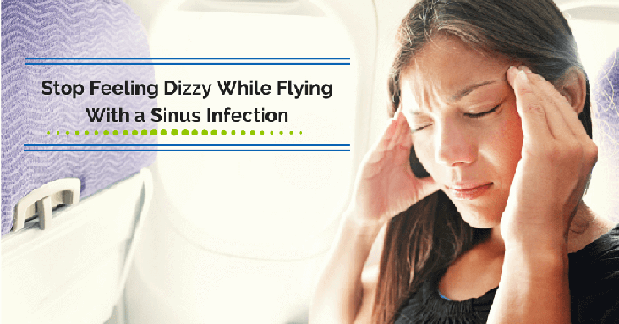
Flying is stressful enough to begin with – long lines, onerous security procedures, endless delays, and the sheer boredom of sitting in a cramped metal tube thousands of feet above sea level until you finally reach your destination. What’s even worse than that? Flying with the pressure, pain and dizziness of sinusitis!
Sinus Infection 101
People often confuse a cold or flu with a sinus infection, because all can have nasal congestion in common. Yet sinusitis, as it is medically known, is a fairly common occurrence involving inflammation of the sinuses, usually caused by bacteria or a virus.
The sinuses are those four hollow cavities in the skull behind your eyes and nose, and they have names worthy of medieval knights: ethmoid, maxillary, sphenoid, and frontal. Normally the sinuses are filled with pockets of air, but they can also fill with fluid (often after a cold or flu).
Subsequently, infection occurs, causing the sinuses’ protective mucous layer to swell. This clogging and swelling can occur in any or all of the four sinus cavities, and it can cause the following symptoms to occur:
- Nasal congestion, discharge and drip
- Fever
- Ear pain
- Throat pain & cough
- Pain under the eye, around the cheeks and face, in the upper jaw and mouth, or down one side of the nose
- Sinus pain that gets worse when reclining
- Headache or migraine
- Swollen cheeks
- Double vision
- Dizziness
Dizziness and the Sinus Infection
Dizziness is not the most common symptom of a sinus infection, but it’s definitely one of the more serious – and it is exacerbated by flying. The reason for that is that the pain and pressure behind the eyes can cause temporary blurred vision, headaches and even migraines, all of which can lead to a dizzy, disoriented feeling.
When flying, the sensation is aggravated by the changes in altitude, which affect cabin pressure during takeoff and landing. Infections of the middle ear, which are caused by fluid buildup behind the eardrum, can also cause a great deal of pain, nausea and even vertigo.
“Taking rest when not feeling well because of sinusitis can do extensive help. Doing activities can just worsen dizziness and sometimes causes nausea. Just lie down and relax,” according to Sinuscure.org.
How to Fly More Comfortably With a Sinus Infection
Most physicians advise their patients to avoid flying altogether when an active sinus or ear infection is raging, but if you absolutely have to fly, there are things you can do to minimize the painful, dizzy feeling.
Home remedies
- Take 1 tsp of apple cider vinegar 3x daily for the five days leading up to your flight to help the infection
- Steaming, to open nasal passages
Medication
- Antibiotics
- Decongestants (nose drops or nasal sprays)
- Expectorants
- Anti-inflammatory drugs
- OTC pain relievers
Treat Your Sinus Infection Before You Fly
It’s crucial to consult ENT doctor when you suspect a sinus infection, because delaying treatment for long enough can result in surgery becoming necessary to remove chronically infected tissues, such as Endoscopic sinus surgery or Turbinate reduction.
But with routine treatment, the pain and dizziness should go away within days – making your biggest in-flight problem whether to choose the Chablis or the Chardonnay. Book an assessment with Dr. Nguyen at Houston Sinus & Allergy, who has specialized in Sinus infections as well as ear infections for over a decade, and travel with comfort!
Share Tweet Email If your teeth ache, you probably call your dentist for an appointment. You naturally assume that pain is the result of a cavity or other dental issue. But it could be that the pain is not triggered by a dental problem. Instead, your sinuses could be the culprit, especially if the pain […]
Share Tweet Email It can be debilitating pain—that pressure in the sinuses that makes your eyes, cheeks and forehead hurt and be sensitive to even a light touch. It has us reaching for pain relievers. But if you’re pregnant, you need to be careful about medication. So how can you relieve that pressure and start […]
